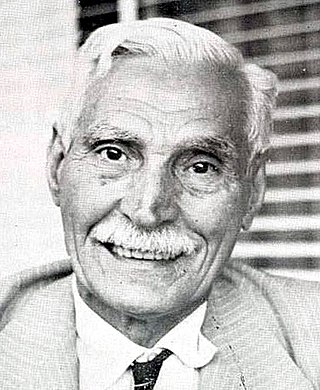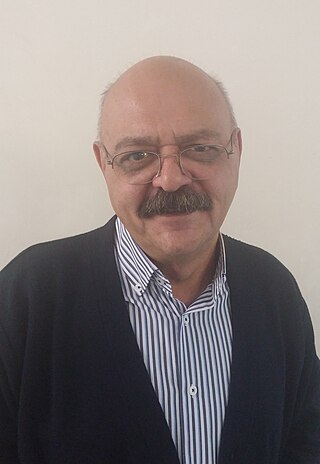Related Research Articles

Sign languages are languages that use the visual-manual modality to convey meaning, instead of spoken words. Sign languages are expressed through manual articulation in combination with non-manual markers. Sign languages are full-fledged natural languages with their own grammar and lexicon. Sign languages are not universal and are usually not mutually intelligible, although there are also similarities among different sign languages.
Auslan is the sign language used by the majority of the Australian Deaf community. The term Auslan is a portmanteau of "Australian Sign Language", coined by Trevor Johnston in the 1980s, although the language itself is much older. Auslan is related to British Sign Language (BSL) and New Zealand Sign Language (NZSL); the three have descended from the same parent language, and together comprise the BANZSL language family. Auslan has also been influenced by Irish Sign Language (ISL) and more recently has borrowed signs from American Sign Language (ASL).

The Academy of Persian Language and Literature (APLL) is the regulatory body for the Persian language, headquartered in Tehran, Iran. Formerly known as the Academy of Iran, it was founded on May 20, 1935, by the initiative of Reza Shah, the founder of Pahlavi dynasty.

The Persian alphabet, also known as the Perso-Arabic script, is the right-to-left alphabet used for the Persian language. It is a variation of the Arabic alphabet with five additional letters: پ چ ژ گ, in addition the obsolete ڤ.

Irish Sign Language is the sign language of Ireland, used primarily in the Republic of Ireland. It is also used in Northern Ireland, alongside British Sign Language (BSL). Irish Sign Language is more closely related to French Sign Language (LSF) than to BSL, though it has influence from both languages. It has influenced sign languages in Australia and South Africa, and has little relation to either spoken Irish or English. ISL is unique among sign languages for having different gendered versions due to men and women being taught it at different schools all over Ireland.

Shams-i Tabrīzī or Shams al-Din Mohammad (1185–1248) was a Persian Shafi'ite poet, who is credited as the spiritual instructor of Mewlānā Jalāl ad-Dīn Muhammad Balkhi, also known as Rumi and is referenced with great reverence in Rumi's poetic collection, in particular Diwan-i Shams-i Tabrīzī. Tradition holds that Shams taught Rumi in seclusion in Konya for a period of forty days, before fleeing for Damascus. The tomb of Shams-i Tabrīzī was recently nominated to be a UNESCO World Heritage Site.

Hamid Hassani is an Iranian scholar and researcher, concentrated on Persian lexicography, dictionary-making, and Persian corpus linguistics, also an expert on Persian, Standard Arabic, and Kurdish prosody.
Audism as described by deaf activists is a form of discrimination directed against deaf people, which may include those diagnosed as deaf from birth, or otherwise. Tom L. Humphries coined the term in his doctoral dissertation in 1975, but it did not start to catch on until Harlan Lane used it in his writing. Humphries originally applied audism to individual attitudes and practices; whereas Lane broadened the term to include oppression of deaf people.
Indo-Pakistani Sign Language (IPSL) is the predominant sign language in the subcontinent of South Asia, used by at least 15 million deaf signers. As with many sign languages, it is difficult to estimate numbers with any certainty, as the Census of India does not list sign languages and most studies have focused on the north and urban areas. As of 2021, it is the most used sign language in the world, and Ethnologue ranks it as the 151st most "spoken" language in the world.
Al-Sayyid Bedouin Sign Language (ABSL) is a village sign language used by about 150 deaf and many hearing members of the al-Sayyid Bedouin tribe in the Negev desert of southern Israel.
Manually coded languages (MCLs) are a family of gestural communication methods which include gestural spelling as well as constructed languages which directly interpolate the grammar and syntax of oral languages in a gestural-visual form—that is, signed versions of oral languages. Unlike the sign languages that have evolved naturally in deaf communities, these manual codes are the conscious invention of deaf and hearing educators, and as such lack the distinct spatial structures present in native deaf sign languages. MCLs mostly follow the grammar of the oral language—or, more precisely, of the written form of the oral language that they interpolate. They have been mainly used in deaf education in an effort to "represent English on the hands" and by sign language interpreters in K-12 schools, although they have had some influence on deaf sign languages where their implementation was widespread.
Old Azeri is the extinct Iranian language that was once spoken in the northwestern Iranian historic region of Azerbaijan before the Turkification of the region. Some linguists believe the southern Tati varieties of Iranian Azerbaijan around Takestan such as the Harzandi and Karingani dialects to be remnants of Old Azeri. Along with Tat dialects, Old Azeri is known to have strong affinities with Talysh and Zaza language and Zaza and Talysh are considered to be remnants of old Azeri. Iranologist linguist W. B Henning demonstrated that Harzandi has many common linguistic features with both Talysh and Zaza and positioned Harzandi between the Talysh and Zaza.
Bimodal bilingualism is an individual or community's bilingual competency in at least one oral language and at least one sign language, which utilize two different modalities. An oral language consists of a vocal-aural modality versus a signed language which consists of a visual-spatial modality. A substantial number of bimodal bilinguals are children of deaf adults (CODA) or other hearing people who learn sign language for various reasons. Deaf people as a group have their own sign language(s) and culture that is referred to as Deaf, but invariably live within a larger hearing culture with its own oral language. Thus, "most deaf people are bilingual to some extent in [an oral] language in some form". In discussions of multilingualism in the United States, bimodal bilingualism and bimodal bilinguals have often not been mentioned or even considered. This is in part because American Sign Language, the predominant sign language used in the U.S., only began to be acknowledged as a natural language in the 1960s. However, bimodal bilinguals share many of the same traits as traditional bilinguals, as well as differing in some interesting ways, due to the unique characteristics of the Deaf community. Bimodal bilinguals also experience similar neurological benefits as do unimodal bilinguals, with significantly increased grey matter in various brain areas and evidence of increased plasticity as well as neuroprotective advantages that can help slow or even prevent the onset of age-related cognitive diseases, such as Alzheimer's and dementia.

Mirza Jabbar Asgarzadeh famously known as Jabbar Baghcheban was an Iranian inventor. He is well known as someone who established the first Iranian kindergarten and the first deaf school in Tabriz. He was also the inventor of Persian language cued speech. He was the father of the late Iranian composer Samin Baghcheban. In total he had three children.
Naser Manzuri is an Iranian novelist and linguist, born in 1953 in Mianeh.
Iranian Persian, Western Persian or Western Farsi, natively simply known as Persian, refers to the varieties of the Persian language spoken in Iran and by minorities in neighboring countries, as well as by Iranian communities throughout the world. These are mutually intelligible with other varieties of Persian, including Afghanistan's Dari and Tajikistan's Tajiki.
Algerian Jewish Sign Language (AJSL), also known as Ghardaia Sign Language, is a moribund village sign language originally of Ghardaïa, Algeria that is now used in Israel and possibly also in France.

Kourosh Safavi was an Iranian linguist, translator, and university professor. He was the vice-president of the Linguistics Society of Iran and a professor at Allameh Tabataba'i University in Tehran. His work focused on semantics, semiotics, history of linguistics, and the relationship between linguistics and literature.

Zabân-e Pâk is a treatise written in 1944 by Ahmad Kasravi, an Iranian author, contains an edition of the Persian language, which shows some difficulties in refining the language.
The history of deafness in Iceland includes the history of Icelandic Sign Language (ISL) and its status as the first language of the Deaf, the history of Icelandic Deaf education and Deaf organizations, and the status of hearing screenings in the country.
References
- 1 2 Iranian Sign Language at Ethnologue (26th ed., 2023)

- ↑ Siyavoshi, Sara (2017). "The Role of the Nondominant Hand in ZEI Discourse Structure". Sign Language Studies. 18 (1): 58–72. ISSN 0302-1475. JSTOR 26478212.
- ↑ Choubsaz, Yassaman; Crasborn, Onno; Siyavoshi, Sara; Soleimanbeigi, Farzaneh (June 2022). "Documenting the Use of Iranian Sign Language (ZEI) in Kermanshah". Proceedings of the LREC2022 10th Workshop on the Representation and Processing of Sign Languages: 37–41.
- ↑ Guity, Ardavan (2021-02-11). "Reflections on the names of the sign language of Iran, and a proposal". Acadeafic. Retrieved 2022-12-19.
- ↑ Madrasi, Yahya; Bijari, Maryam (2011). زبان و فرهنگ ناشنوایان تهرانی [Language and culture of Tehrani deaf people]. نامه انسان شناسی (in Persian). 1 (2): 15–46. SID: 66388.
- ↑ Guity, Ardavan (April 2022). Esharani Grammatical Sketch: An Initial Description of the Lexicon and Grammar (PhD thesis). Gallaudet University. doi:10.1075/sll.00077.gui.